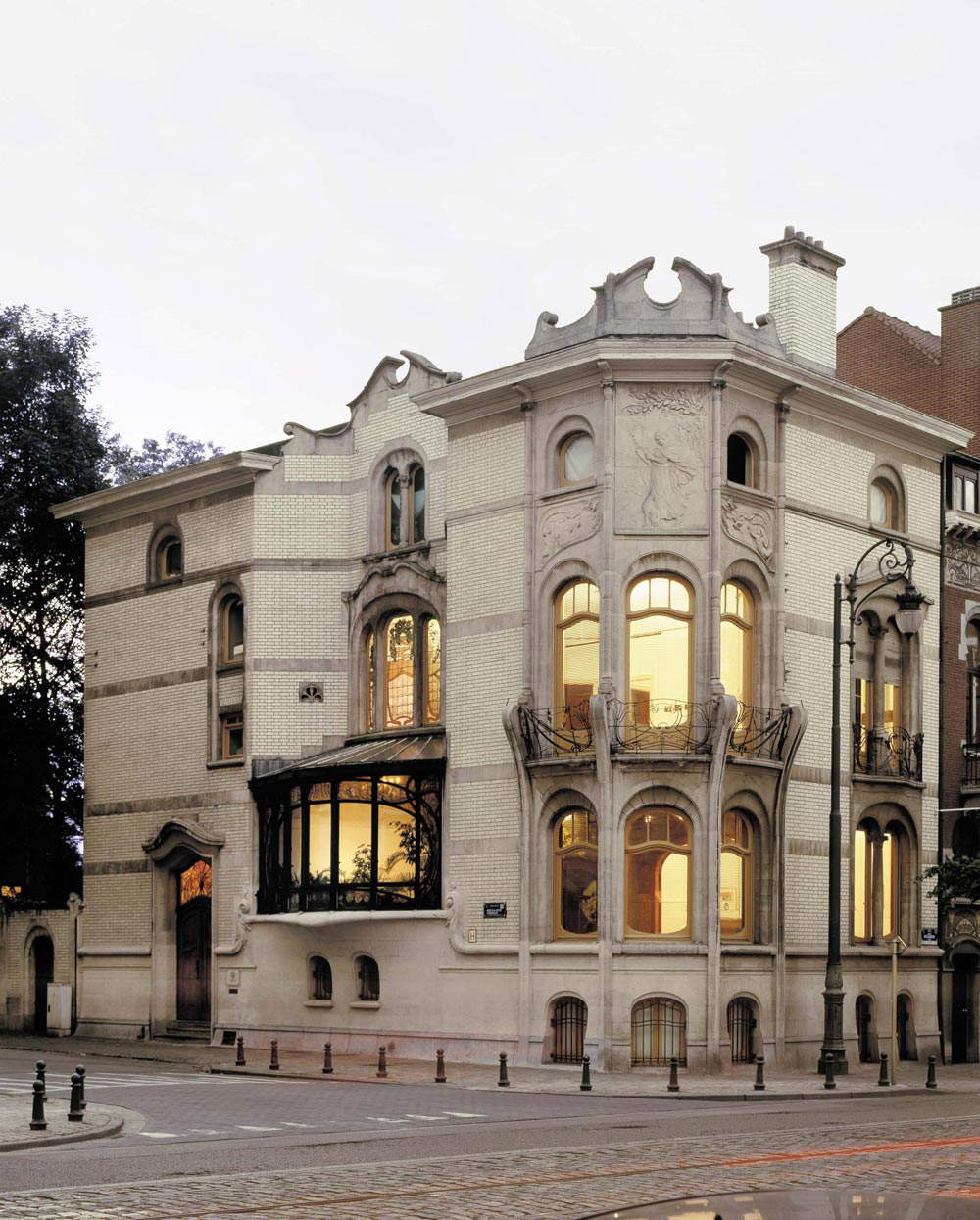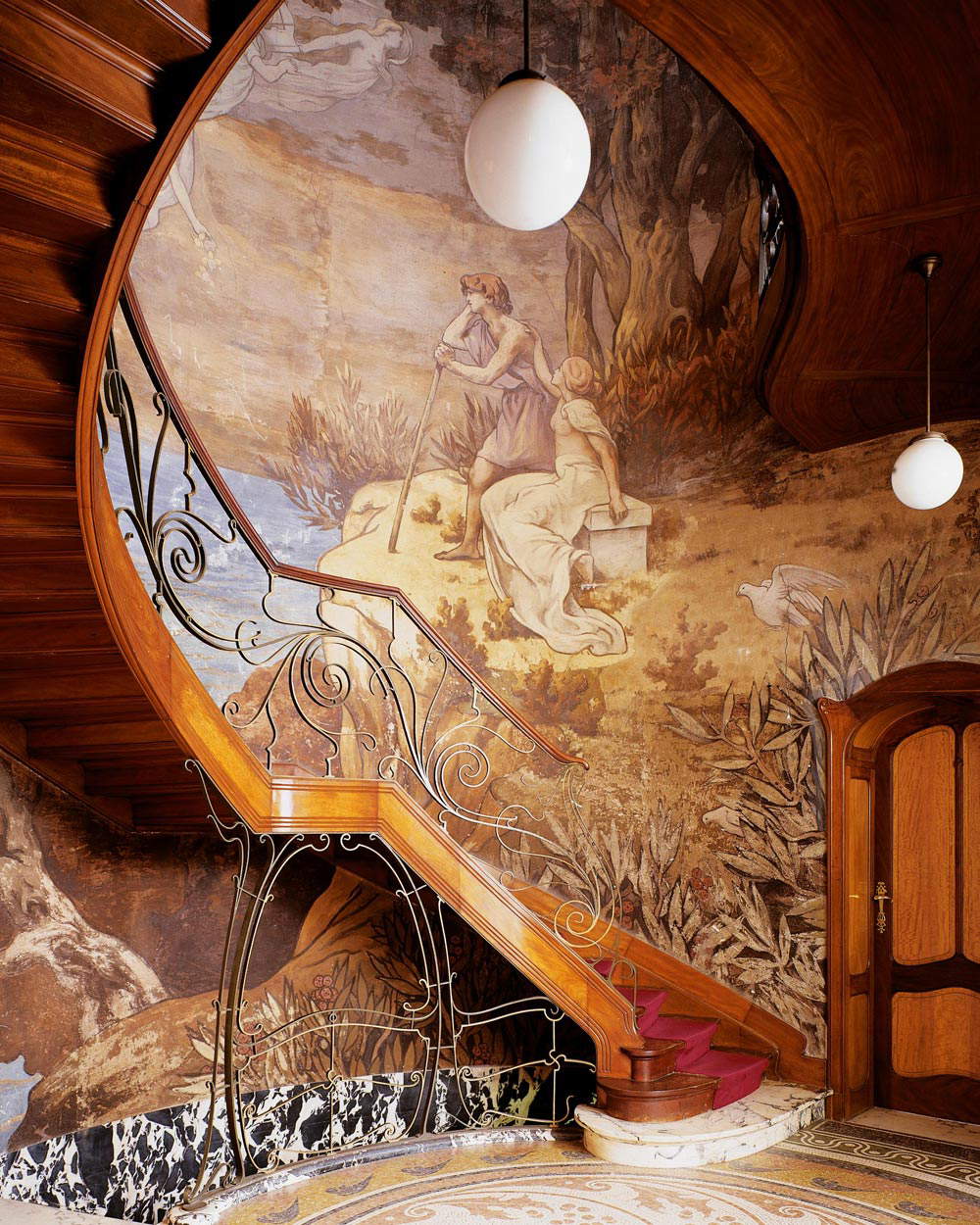Brussels, after nine years of restoration, an Art Nouveau jewel opens: Maison Hannon
In Brussels , a jewel of Belgium’sArt Nouveau is once again shining. In fact, as of June 2023, after a restoration that lasted a full 9 years, the public can return to visit the splendid Maison Hannon. This is a valuable recovery supported by the Horta Museum, announced in advance last January at BRAFA Art Fair by the Association of Antiquarians of Belgium. In fact, the organizers of Europe’s oldest art and antiques event dedicated the 68th edition to Art Nouveau with hundreds of works that met with the interest of an unprecedented public.
Until June 1, 2024, the house commissioned by Édouard Hannon (1853-1931), an engineer for the Solvay company, and his wife Marie Debard (1857-1926), and designed in 1902 by their friend architect Jules Brunfaut (1852-1942), is hosting on the second floor the exhibition Art(s) Nouveau(x) Belge(s): van de Velde, Serrurier-Bovy, Hankar & Co, curated by Werner Adriaenssens, which chronicles the “counter-song” of these artist architects to the great Victor Horta, right across the street from the museum dedicated to him. If in fact the Hôtel Tassel designed by Victor Horta in 1893 is considered the birth certificate and manifesto of Art Nouveau, the expression was first used by Edmond Picard in 1894 in an article published in the Belgian magazine L’Art moderne to qualify the artistic production of Henry van de Velde. It was, however, van de Velde himself with Horta, Paul Hankar and Gustave Serrurier-Bovy who had devised the name, based on the fact that the common quality of their art was “novelty” although it then had different declinations not only according to individual personalities but also to the specializations to which it was applied: architecture, interior and urban decoration, jewelry, furniture and textiles, utensils and giftware, and lighting.
Maison Hannon combines Belgian art nouveau with French art nouveau in a symbolic and dreamlike universe. Built on the corner of Avenue Brugmann and Avenue de la Jonction in Saint-Gilles, the house fulfilled the dream of Mr. and Mrs. Hannon: Édouard Hannon was, as mentioned, an engineer, hired at the age of twenty-three by the Solvay group and sent to Dombasle, in the suburbs of Nancy (Lorraine, France), to work in the company’s first factory built abroad. Considered one of the group’s most efficient managers, his sensitivity to social issues did not prevent him from being critical of the hierarchy. In 1879 he married Marie Debard in Dombasle, only to be recalled in 1883 to the Ixelles headquarters, where he reformed the group’s worldwide production, in a role that gave him the opportunity to travel to Europe, Russia, the United States, and engage in photographic work. In 1907, Alfred and Ernest Solvay appointed him to the position of CEO, the only person to hold this position who was not from the family.




Today the Hannon name is associated with the house but also with photography. In fact, Édouard Hannon was also a photographer, a leading exponent of Belgian Pictorialism , and participated in the founding of theBelgian Photographic Association, which worked to elevate this medium to the status of art, and in 1894 won the gold medal at the first Paris-Club exhibition in Paris. A leading Belgian figure in the movement, his work shows great technical mastery and both a sociological and documentary view of the subjects he photographed during his travels. Social realism and ancient architecture mingle with industrial landscapes and sublimations of nature.
Conceived as a closed, dreamlike, symbolist universe, Maison Hannon is a synthesis of Marie’s taste for botany and Édouard’s taste for poetry, antiquity, and technology. The 1900 Paris Exposition was decisive for the couple, who met the French master of Art nouveau, Emile Gallé, here. They enthusiastically asked their friend Jules Brunfaut (1852-1942) to draw inspiration from the houses of Victor Horta (his personal house, Hotel Tassel and Wessinger), Ernest Blérot (his personal house, now destroyed), Octave Van Rysselbeghe and Henry Van de Velde (Hotel Otlet), to create a unique work.
At the time, the building was called “Hôtel Hannon,” probably to give it a high patina when the art nouveau style was not appreciated. Moreover, from the point of view of architectural criteria, the building meets none of them: no driveway entrance or vestibule for car passage, no back stairs for servants, semi-basement kitchens, rather narrow façade width, and so on. The greenhouse, built entirely of metal, literally overflows the street and distinguishes the house. In addition, architect Brunfaut placed at the corner of the two avenues a bas-relief by sculptor Victor Rousseau (1865-1954), which is an allegory of time suspended at sunset.
This work is the symbolist key to understanding the philosophy of the interiors, furnished entirely (a real exception) by the establishments of Émile Gallé (chandeliers and furniture), decorated by contemporary works by James Ensor, Victor Rousseau or Émile Claus. Extensive frescoes by Paul Baudouin (1844-1931), a disciple of the artist Puvis de Chavannes, are displayed as tapestries in the stairwell and salon. Allegories of the couple’s maturity are depicted with antique decoration, while marbles and mosaics of great variety respond. In short, Belgian, French, and Edward and Marie’s personal tastes are combined here. In this sense one can speak of a portrait house.
When the couple’s daughter Hannon died in 1965, the family decided to sell the property, which was subject to theft, damage and looting. In 1972, Marie Van Mulders-Brunfaut, daughter of Jules Brunfaut, raised the alarm with the Royal Commission for Sites and Monuments of Belgium, and in 1976 the façade and roof were bound to prevent building speculation. In the meantime, Art Nouveau had become an object of attention and the building was visited on numerous occasions. In 1979 the municipality of Saint-Gilles acquired the property, intending to preserve the building at a time when its dilapidated state was the subject of much press attention.
In 1983, the interior was also listed and an extensive restoration campaign was launched. The goal was to save what could be preserved by modernizing the place to install the Contretype gallery. Contretype was inaugurated on September 21, 1988 by Charles Picqué, and under the impetus of Contretype director Jean-Louis Godefroid, the gallery organized numerous exhibitions and worked actively to promote the work of Édouard Hannon and the building. Unfortunately, in 2014, the gallery left the building and the City Council embarked on a new restoration campaign to save the severely deteriorated stairwell fresco and restore the mosaics, windows, and conservatory. In 2019, at the initiative of the municipality and the region, the nonprofit Maison Hannon was founded to open the building as a museum. And today it can finally be visited. For information you can visit the Maison Hannon website.
 |
| Brussels, after nine years of restoration, an Art Nouveau jewel opens: Maison Hannon |
Warning: the translation into English of the original Italian article was created using automatic tools. We undertake to review all articles, but we do not guarantee the total absence of inaccuracies in the translation due to the program. You can find the original by clicking on the ITA button. If you find any mistake,please contact us.





























